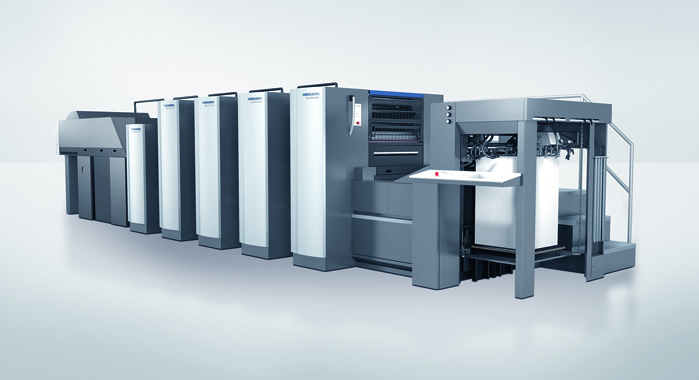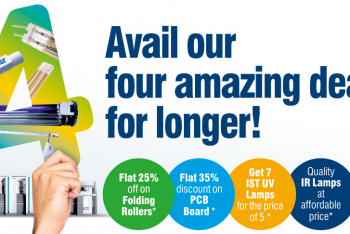PRODUCT OF THE MONTH: HEIDELBERG SPEEDMASTER CX 75
Heidelberg has unveiled a new B2 press designed to fill the gap between XL and SX models. With optimum automation levels, this press offers an ideal price-performance bargain that a typical Indian buyer seeks, finds out Rushikesh Aravkar.
When PrintWeek India spoke to the 111 print firms who have made significant investments in the last 12 months for our anniversary issue in May, three things emerged. One, the Indian printer now realises the significance of workflow software and process automation on the shopfloor, which a few years ago was regarded as ‘only-for-biggies’ product. Two, the need for automation is driven by the urge to turnaraound more number of jobs in less time and beat the competition, but the current print volumes do not make economic sense to invest in high-end automation. Three, if the value offered makes business sense and fits his pocket, even a small Indian printer in C-tier city is willing to invest.
In that sense, this month’s Product of the Month, the Heidelberg Speedmaster CX 75, which was introduced at China Print last month, is an ideal offering for the Indian market.
The mid-range Speedmaster CX 75 is Heidelberg’s latest B2 Speedmaster, a hybrid press that combines elements from its XL 75 B2 flagship and the SX 74.
The most striking feature of CX 75 is its footprint, which aptly addresses the pressing issue of every Indian printer, the constraints with space. The CX 75 has a width of 2.81-metre and 2.05-metre height. It is the narrowest printing press designed by Heidelberg in the B2 (50x70cm) format. A five-unit press with coating unit will be 11.6-metre long.
For Heidelberg the CX 75 is an important press as it closes the gap between its Speedmaster SX 74 and XL 75 models, and completes its portfolio in the B2 format.
“The first commercial deliveries are slated for November,” informs Heidelberg’s managing director in India, Klaus Nielsen. “The Speedmaster CX 75 combines the best of both worlds – the innovative platform of Speedmaster XL 75 combined with the components of SX 74.”
The machine is based on the XL 75 platform, in terms paper travel and delivery, but uses a number of SX 74 components, including the suction head feeder, to minimise footprint and keep its price down. Unlike the XL 75, it does not come with a perfector option.
This Speedmaster CX 75 press is available in two formats. The C format, focused on commercial print, handles sheet size of 530x750mm, while the F format, which has also been available for XL 75, is well suited for board printing and inflexible substrates, with a maximum sheet size of 605x750mm. The F format with that extended print area is an interesting choice for packaging applications as it allows the user to accommodate additional ups of cartons or labels in one impression than in C format.
Thanks to its double diameter impression cylinders, just like in XL 75, the CX 75 can take substrates ranging from 0.03mm to 0.6mm in thickness. The top production speed is 15,000 sheets per hour. The CX 75 is available in four, five and six colours with a coating unit.
It has a fully automated wash programme as standard and even though it not a machine in Heidelberg’s high performance XL series, it still can be fully integrated with Heidelberg’s Prinect Press Centre 2 digital workflow, allowing for makereadies of less than five minutes and easy data transfer. The integration with a digital workflow is a big plus as the printing machine pulls all the necessary information for job setting from the software. Thus, most of the tasks in readying a press for the new job such as positions of side lays, feeder and vacuum belt and adjustments for suction and blowers on the basis of weight and size of the substrate are completed automatically. These settings can be logged for later recall.
“The Indian market is an excellent market for the SX 74 and there is a huge potential install base for this machine, especially because the customers want to grow and go to different markets, where packaging is more involved,” Nielsen said. “It will also be of interest to those print shops that operate one or two shifts and are looking for an attractive price-performance ratio.”
The user can choose between three different drying technologies with the DryStar dryer matched to the sheet travel of the Speedmaster CX 75. It can run with classic UV for carton printing as well as LE-UV and LED UV. The DryStar LE (low energy) UV dryer uses highly reactive UV inks and coatings, and therefore needs less energy. The DryStar LED dryer achieves the highest energy efficiency among the three. This again emphasises the versatility that Heidelberg is looking for. It suits “the growth in new applications without the need for excessive investment” says Nielsen.
During China Print 2017, Heidelberg’s booth featured a four-colour CX 75 running the company’s DryStar LED technology.
Competitive market
The B2 market is a very competitive space, with a wide array of alternatives, and Heidelberg knows it has a tough battle on its hands if it wants to significantly increase its market share.
So what are the main strengths and highlights about the CX75 in this crowded market? Smaller footprint, attractive price-performance ratio and the optimum level of automation will play in Heidelberg’s favour in the B2 segment.
Moreover, Heidelberg is an established brand in the market and most of its Indian customers swear by the service support and technical prowess that it possesses. This will definitely be a huge advantage for the manufacturer.
SPECIFICATIONS
Max sheet size 530×750 mm
Min sheet size 280×350 mm
Substrate thickness 0.03 mm – 0.60 mm
0.03 mm – 0.80 mm (option)
Max speed 15,000 sph
Contact Peter Rego
Heidelberg India
peter.rego@heidelberg.com
THE ALTERNATIVES
Komori Lithrone G29
The 16,500sph press is bristling with the latest automation systems for fast makeready and job changeovers, and is targeted at added-value printing applications. The maximum sheet size is 530x750mm and the G29 handles stock up to 0.6mm in thickness.
Max sheet size 530×750 mm
Max speed 16,500 sph (straight printing)
Contact Sangam Khanna
Insight Communication & Print Solution India
sangamk@insightwithin.com
RMGT 760
The 760 models boast “excellent cost performance” to meet printing market needs for lower costs. The maximum printing area is large enough to easily handle 8-up printing of B5 size, and integration of the operation stand into the press reduces installation space. The press can be configured from two to six-colour unit as a straight or a perfecting press.
Max sheet size 600×765 mm
Min sheet size 200×279 mm
Substrate thickness 0.04 mm – 0.6 mm
Max speed 13,000 sph
Contact Vinay Kaushal Provin Technos vinay@provin.in
RMGT 790
The 790 models, according to the company, can be configured according to user needs, providing the optimum printing environment for increasing productivity and profitability. The thick cardboard specification model can handle sheet thicknesses up to 0.8 mm
Max sheet size 600×788 mm
Min sheet size 200×279 mm
Substrate thickness 0.04 – 0.6 mm
(Thick cardboard specification: 0.04 – 0.8 mm)
Max speed 16,000 sph (straight printing)
Contact Vinay Kaushal Provin Technos vinay@provin.in
Source: http://www.printweek.in/




LEAVE A REPLY